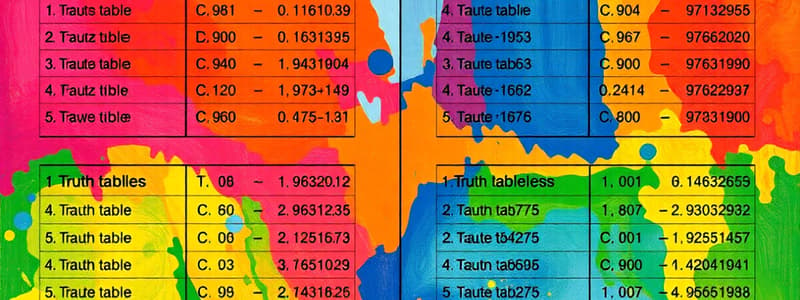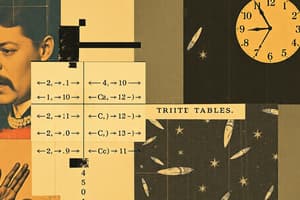Podcast
Questions and Answers
Which of the following is an example of a proposition?
Which of the following is an example of a proposition?
- What time is it?
- The Moon is made of green cheese. (correct)
- Sit down!
- x + 1 = 2
A negation is a logical connective that flips the truth value of a proposition.
A negation is a logical connective that flips the truth value of a proposition.
True (A)
What is the primary function of truth tables in propositional logic?
What is the primary function of truth tables in propositional logic?
To determine the truth values of propositions based on their connectives.
A proposition that is formed by combining two simpler propositions using the word 'and' is called a __________.
A proposition that is formed by combining two simpler propositions using the word 'and' is called a __________.
Match the logical connectives to their definitions:
Match the logical connectives to their definitions:
What is the result of the conjunction of two propositions T and F?
What is the result of the conjunction of two propositions T and F?
The statement 'The earth is not round' is the negation of the proposition 'The earth is round'.
The statement 'The earth is not round' is the negation of the proposition 'The earth is round'.
What symbol represents negation in propositional logic?
What symbol represents negation in propositional logic?
The disjunction of propositions p and q is denoted by p ______ q.
The disjunction of propositions p and q is denoted by p ______ q.
Match each logical connective with its function:
Match each logical connective with its function:
Which connective describes the following statement: 'If it is raining, then I will stay indoors'?
Which connective describes the following statement: 'If it is raining, then I will stay indoors'?
The proposition that is always true is denoted by F.
The proposition that is always true is denoted by F.
What is the truth value of the expression p ∨ q when both p and q are false?
What is the truth value of the expression p ∨ q when both p and q are false?
What type of quantifier asserts that a property holds for all elements of a given domain?
What type of quantifier asserts that a property holds for all elements of a given domain?
Predicate Logic is sufficient to represent all logical statements that can be formed with propositional logic.
Predicate Logic is sufficient to represent all logical statements that can be formed with propositional logic.
What is the predicate in the expression P(x) if P is defined as 'x is greater than zero'?
What is the predicate in the expression P(x) if P is defined as 'x is greater than zero'?
The process of replacing variables in a propositional function with values from their domain is called __________.
The process of replacing variables in a propositional function with values from their domain is called __________.
Match the following propositional functions with their corresponding truth values:
Match the following propositional functions with their corresponding truth values:
Which of the following statements best defines a valid argument in logic?
Which of the following statements best defines a valid argument in logic?
Existential quantifiers can be negated by rephrasing them as universal quantifiers.
Existential quantifiers can be negated by rephrasing them as universal quantifiers.
Provide an example of a statement that can be represented by an existential quantifier.
Provide an example of a statement that can be represented by an existential quantifier.
Flashcards
Proposition
Proposition
A declarative sentence that is either true or false.
Propositional Logic
Propositional Logic
The area of logic that deals with propositions and their relationships.
Connectives
Connectives
Symbols used to connect propositions, such as AND, OR, NOT, Implication and Biconditional.
Negation
Negation
Signup and view all the flashcards
Conjunction
Conjunction
Signup and view all the flashcards
Disjunction
Disjunction
Signup and view all the flashcards
Implication
Implication
Signup and view all the flashcards
Biconditional
Biconditional
Signup and view all the flashcards
Truth Table
Truth Table
Signup and view all the flashcards
Negation of p
Negation of p
Signup and view all the flashcards
Conjunction (p∧q)
Conjunction (p∧q)
Signup and view all the flashcards
Disjunction (p∨q)
Disjunction (p∨q)
Signup and view all the flashcards
Propositional Variable
Propositional Variable
Signup and view all the flashcards
Compound Proposition
Compound Proposition
Signup and view all the flashcards
Truth Table
Truth Table
Signup and view all the flashcards
Predicate Logic
Predicate Logic
Signup and view all the flashcards
Propositional Function
Propositional Function
Signup and view all the flashcards
Predicate
Predicate
Signup and view all the flashcards
Variable
Variable
Signup and view all the flashcards
Quantifier
Quantifier
Signup and view all the flashcards
Universal Quantifier
Universal Quantifier
Signup and view all the flashcards
Existential Quantifier
Existential Quantifier
Signup and view all the flashcards
Domain
Domain
Signup and view all the flashcards
R(2, -1, 5)
R(2, -1, 5)
Signup and view all the flashcards
Q(3, 4, 7)
Q(3, 4, 7)
Signup and view all the flashcards
Study Notes
Propositions
- A proposition is a declarative statement that is either true or false.
Negation
- A negation is a logical connective that flips the truth value of a proposition.
- For example, the negation of "The sky is blue" is "The sky is not blue".
Truth Tables
- Truth tables are primarily used to evaluate the truth values of complex propositions based on the truth values of their components.
- They help determine the truth value of a compound proposition for all possible combinations of truth values of its individual components.
Conjunction
- A proposition formed by combining two simpler propositions using the word 'and' is called a conjunction.
- The conjunction of propositions p and q is denoted by p ∧ q.
Conjunction of True and False
- The result of the conjunction of two propositions T and F is F.
Negation Symbol
- The symbol that represents negation in propositional logic is ¬.
Disjunction
- The disjunction of propositions p and q is denoted by p ∨ q.
Logical Connectives
- Conjunction (∧): Represents "and"
- p ∧ q is true only if both p and q are true.
- Disjunction (∨): Represents "or"
- p ∨ q is true if at least one of p or q is true.
- Negation (¬): Represents "not"
- ¬p is true if p is false.
- Conditional (→): Represents "if...then"
- p → q is true unless p is true and q is false.
Conditional Statement
- The connective that describes the statement "If it is raining, then I will stay indoors" is the conditional connective (→).
Tautology
- The proposition that is always true is denoted by T (or sometimes 1).
Disjunction of False Propositions
- The truth value of the expression p ∨ q when both p and q are false is F.
Universal Quantifier
- A universal quantifier asserts that a property holds for all elements of a given domain.
- It is symbolized by ∀.
Predicate Logic
- Predicate Logic can represent all logical statements that can be formed with propositional logic.
- This is because predicate logic has the power to handle quantifiers and relations, which can be used to express more complex statements.
Predicate
- In the expression P(x) if P is defined as 'x is greater than zero', the predicate is "x is greater than zero".
Instantiation
- The process of replacing variables in a propositional function with values from their domain is called instantiation.
Propositional Function Truth Values
- P(x): x is greater than 5
- P(3): False
- P(7): True
- Q(x): x is an even number
- Q(4): True
- Q(9): False
Valid Argument Definition
- A valid argument in logic is one where the conclusion logically follows from the premises.
- This means that if all the premises are true, then the conclusion must also be true.
Existential Quantifier Negation
- Existential quantifiers can be negated by rephrasing them as universal quantifiers.
Existential Quantifier Example
- "There exists a person who is over 100 years old"
- This statement can be represented by the existential quantifier: ∃x (Person(x) ∧ Age(x) > 100).
Studying That Suits You
Use AI to generate personalized quizzes and flashcards to suit your learning preferences.




